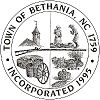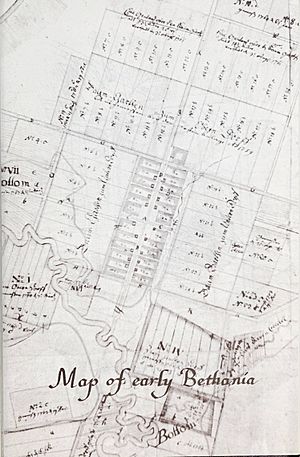Bethania, North Carolina facts for kids
Quick facts for kids
Bethania, North Carolina
|
||
|---|---|---|
|
||

Location in Forsyth County and the state of North Carolina
|
||
| Country | United States | |
| State | North Carolina | |
| County | Forsyth | |
| Founded | 1759 | |
| Incorporated | 1839, 1995 | |
| Named for | Bethany | |
| Area | ||
| • Total | 0.68 sq mi (1.77 km2) | |
| • Land | 0.68 sq mi (1.76 km2) | |
| • Water | 0.01 sq mi (0.01 km2) | |
| Elevation | 804 ft (245 m) | |
| Population
(2020)
|
||
| • Total | 344 | |
| • Density | 506.63/sq mi (195.75/km2) | |
| Time zone | UTC-5 (Eastern (EST)) | |
| • Summer (DST) | UTC-4 (EDT) | |
| ZIP code |
27010
|
|
| Area code(s) | 336 | |
| FIPS code | 37-05340 | |
| GNIS feature ID | 2405252 | |
Bethania is a small town in North Carolina, United States. It is the oldest town in Forsyth County. Bethania was first established in 1759. It became a town again in 1995, bringing back its original town rules from 1838. In 2009, Bethania celebrated its 250th birthday! According to the 2020 census, about 341 people live there.
Contents
History of Bethania
Bethania was the very first planned settlement by the Moravian people in North Carolina. It is still the only independent Moravian village in the southern United States that has been active continuously. It is also the only known German-style farming village of its kind in the South.
Founding the Village
Bethania was founded on June 12, 1759. It was started by the Moravian Brethren from an area called Wachovia. They planned it as a community where people could live, farm, and trade. Bethania was the first planned Moravian settlement in Wachovia. Its original design, like an old German farming village, is still clear today. Many of its streets and land plots have been used since 1759.
The name "Bethania" comes from the German word for "Bethany." Bethany was a village near Jerusalem mentioned in the New Testament of the Bible. It was home to people like Mary, Martha, and Lazarus.
Revolutionary War Times
During the American Revolutionary War, some local people called the town "HauserTown." This was because many families with the last name Hauser lived there. Mary Hauser was one of the first people buried in Bethania's cemetery, called God's Acre.
Visiting Historic Bethania
In March 2007, the town opened a visitor center and museum called Historic Bethania. This center welcomes visitors and helps teach people about the community's history. It also helps protect its cultural treasures.
The center has an old Moravian farmstead home, the Wolff-Moser House, which dates back to around 1792. This is one of the oldest surviving rural Moravian farm homes in North America. You can visit the Wolff-Moser House during the center's open hours. The visitor center is at 5393 Ham Horton Lane. It also gives out tour maps for exploring the Bethania National Historic Landmark District.
The Bethania Historic District covers about 500 acres. It is the largest historic district of its kind in Forsyth County. Bethania and its old 18th and 19th-century buildings are listed on the National Register of Historic Places. Other historic places listed there include the Dr. Beverly Jones House, John Henry Kapp Farm, and Samuel B. Stauber Farm.
Local Businesses
Bethania Mill and Village Shoppes is the only shopping center in town. It opened on October 18, 2008, where an old seed mill used to be. It has a general store and plans to add a restaurant.
Geography of Bethania
Bethania is located in the northwestern part of Forsyth County. It is completely surrounded by the city of Winston-Salem. The town is about 10 miles (16 km) northwest of Winston-Salem's city center.
The United States Census Bureau says that Bethania covers a total area of about 0.68 square miles (1.8 square kilometers). Only a tiny part of this, about 0.01 square miles (0.01 square kilometers), is water.
Population and People
| Historical population | |||
|---|---|---|---|
| Census | Pop. | %± | |
| 1880 | 105 | — | |
| 2000 | 354 | — | |
| 2010 | 328 | −7.3% | |
| 2020 | 341 | 4.0% | |
| 2021 (est.) | 346 | 5.5% | |
| U.S. Decennial Census | |||
2020 Census Information
As of the 2020 United States census, there were 344 people living in Bethania. These people lived in 146 households, and 115 of those were families.
Here's a look at the different groups of people living in Bethania:
| Race | Number | Percentage |
|---|---|---|
| White (non-Hispanic) | 277 | 80.52% |
| Black or African American (non-Hispanic) | 32 | 9.3% |
| Native American | 1 | 0.29% |
| Pacific Islander | 2 | 0.58% |
| Other/Mixed | 11 | 3.2% |
| Hispanic or Latino | 21 | 6.1% |
See also
 In Spanish: Bethania (Carolina del Norte) para niños
In Spanish: Bethania (Carolina del Norte) para niños



